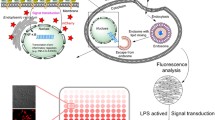Abstract
2-Alkyl-4-quinolones (AQs) such as 2-heptyl-3-hydroxy-4-quinolone (PQS) and 2-heptyl-4-hydroxyquinoline (HHQ) are quorum-sensing signal molecules. Here we describe two methods for AQ detection and quantification that employ thin-layer chromatography (TLC) and microtiter plate assays in combination with a lux-based Pseudomonas aeruginosa AQ biosensor strain. For TLC detection, organic solvent extracts of bacterial cells or spent culture supernatants are chromatographed on TLC plates, which are then dried and overlaid with the AQ biosensor. After detection by the bioreporter, AQs appear as both luminescent and green (from pyocyanin) spots. For the microtiter assay, either spent bacterial culture supernatants or extracts are added to a growth medium containing the AQ biosensor. Light output by the bioreporter correlates with the AQ content of the sample. The assays described are simple to perform, do not require sophisticated instrumentation, and are highly amenable to screening large numbers of bacterial samples.
Access this chapter
Tax calculation will be finalised at checkout
Purchases are for personal use only
Similar content being viewed by others
References
Williams P, Cámara M (2009) Quorum sensing and environmental adaptation in Pseudomonas aeruginosa: a tale of regulatory networks and multifunctional signal molecules. Curr Opin Microbiol 12:182–191
Pesci EC, Milbank JB, Pearson JP, McKnight S, Kende AS, Greenberg EP et al (1999) Quinolone signaling in the cell-to-cell communication system of Pseudomonas aeruginosa. Proc Natl Acad Sci U S A 96:11229–11234
Heeb S, Fletcher MP, Chhabra SR, Diggle SP, Williams P, Cámara M (2011) Quinolones: from antibiotics to autoinducers. FEMS Microbiol Rev 35(2):247–274
Wade DS, Calfee MW, Rocha ER, Ling EA, Engstrom E, Coleman JP et al (2005) Regulation of Pseudomonas quinolone signal synthesis in Pseudomonas aeruginosa. J Bacteriol 187:4372–4380
Xiao G, Déziel E, He J, Lépine F, Lesic B, Castonguay MH et al (2006) MvfR, a key Pseudomonas aeruginosa pathogenicity LTTR-class regulatory protein, has dual ligands. Mol Microbiol 62:1689–1699
Diggle SP, Winzer K, Chhabra SR, Worrall KE, Cámara M, Williams P (2003) The Pseudomonas aeruginosa quinolone signal molecule overcomes the cell density-dependency of the quorum sensing hierarchy, regulates rhl-dependent genes at the onset of stationary phase and can be produced in the absence of LasR. Mol Microbiol 50:29–43
Allesen-Holm M, Barken KB, Yang L, Klausen M, Webb JS, Kjelleberg S et al (2006) A characterization of DNA release in Pseudomonas aeruginosa cultures and biofilms. Mol Microbiol 59:1114–1128
Diggle SP, Lumjiaktase P, Dipilato F, Winzer K, Kunakorn M, Barrett DA et al (2006) Functional genetic analysis reveals a 2-alkyl-4-quinolone signaling system in the human pathogen Burkholderia pseudomallei and related bacteria. Chem Biol 13:701–710
Lépine F, Déziel E, Milot S, Rahme LG (2003) A stable isotope dilution assay for the quantification of the Pseudomonas quinolone signal in Pseudomonas aeruginosa cultures. Biochim Biophys Acta 1622:36–41
Lépine F, Milot S, Déziel E, He J, Rahme LG (2004) Electrospray/mass spectrometric identification and analysis of 4-hydroxy-2-alkylquinolines (HAQs) produced by Pseudomonas aeruginosa. J Am Soc Mass Spectrom 15:862–869
Ortori CA, Dubern JF, Chhabra SR, Cámara M, Hardie K, Williams P et al (2014) Simultaneous quantitative profiling of N-acyl-L-homoserine lactone and 2-alkyl-4(1H)-quinolone families of quorum-sensing signaling molecules using LC-MS/MS. Anal Bioanal Chem 2:839–850
Calfee MW, Coleman JP, Pesci EC (2001) Interference with Pseudomonas quinolone signal synthesis inhibits virulence factor expression by Pseudomonas aeruginosa. Proc Natl Acad Sci U S A 98:11633–11637
Gallagher LA, McKnight SL, Kuznetsova MS, Pesci EC, Manoil C (2002) Functions required for extracellular quinolone signaling by Pseudomonas aeruginosa. J Bacteriol 184:6472–6480
Fletcher MP, Diggle SP, Crusz SA, Chhabra SR, Cámara M, Williams P (2007) A dual biosensor for 2-alkyl-4-quinolone quorum-sensing signal molecules. Environ Microbiol 9:2683–2693
Fletcher MP, Diggle SP, Cámara M, Williams P (2007) Biosensor-based assays for PQS, HHQ and related 2-alkyl-4-quinolone quorum sensing signal molecules. Nat Protoc 2:1254–1262
Diggle SP, Matthijs S, Wright VJ, Fletcher MP, Chhabra SR, Lamont IL et al (2007) The Pseudomonas aeruginosa 4-quinolone signal molecules HHQ and PQS play multifunctional roles in quorum sensing and iron entrapment. Chem Biol 14:87–96
Becher A, Schweizer HP (2000) Integration-proficient Pseudomonas aeruginosa vectors for isolation of single-copy chromosomal lacZ and lux gene fusions. Biotechniques 5:948–952
Acknowledgements
We gratefully acknowledge the Royal Society (SPD) and Wellcome Trust (MPF) for funding.
Author information
Authors and Affiliations
Corresponding author
Editor information
Editors and Affiliations
Rights and permissions
Copyright information
© 2018 Springer Science+Business Media LLC
About this protocol
Cite this protocol
Fletcher, M.P., Diggle, S.P., Cámara, M., Williams, P. (2018). Detection of 2-Alkyl-4-Quinolones Using Biosensors. In: Leoni, L., Rampioni, G. (eds) Quorum Sensing. Methods in Molecular Biology, vol 1673. Humana Press, New York, NY. https://doi.org/10.1007/978-1-4939-7309-5_2
Download citation
DOI: https://doi.org/10.1007/978-1-4939-7309-5_2
Published:
Publisher Name: Humana Press, New York, NY
Print ISBN: 978-1-4939-7308-8
Online ISBN: 978-1-4939-7309-5
eBook Packages: Springer Protocols



